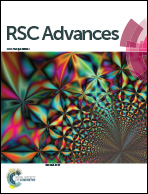Recent advances in electrospun metal-oxide nanofiber based interfaces for electrochemical biosensing
Abstract
The use of unique nanostructured materials has gained substantial importance in the field of biosensing and biomedical applications. Recently, the electrospinning technique has attracted immense attention in the development of nanofiber-based biosensors. Electrospinning has been accepted as a proficient practice for the fabrication of polymer, metal and metal-oxide nanofibers. Electrospinning appears to be the ultimate technique to generate biocompatible and biodegradable polymer/metal-oxide nanofibers, such as carbon, ZnO, TiO2, and NiO, for highly sensitive biosensing applications. Biosensors with enhanced sensitivity are becoming fascinating for the sensing of blood, and in particular for glucose, cholesterol, triglyceride, and low density lipoprotein (LDL) affinity sensing. Electrospinning can deposit a three-dimensional porous nanofibrous mat network on the surface of a sensor transducer, which provides a large global pore volume, predictable pore size distribution, and tunable interconnected porosity. These features of nanofibers can add further suitable functionalities to a sensor for the detection of bio-analytes in a specific environment, where efficient mass transport is needed towards the electrode surface. Electrospun fibers are able to form a highly porous nanofibrous web and their huge surface to volume ratios could lead to very high sensitivity due to their exceptional specific surface areas and interesting nanostructured morphologies, which give rise to properties that do not exist in fibers or wires with a bigger size. Based on the distinctive properties of electrospun nanofibers in the nanoscale that differentiate them from other nanostructures created by other existing methods, we describe in this review the knowledge on nanofibers suitable for biosensor and biomedical applications, including structure and property characterization. Additionally, information on polymers together with metal-oxides precursors and their processing conditions for the electrospinning of ultrafine metal-oxide fibers is briefly described in this paper. Additional relevant issues concerning the research challenges, technology limitations, and future trends are also discussed.


 Please wait while we load your content...
Please wait while we load your content...